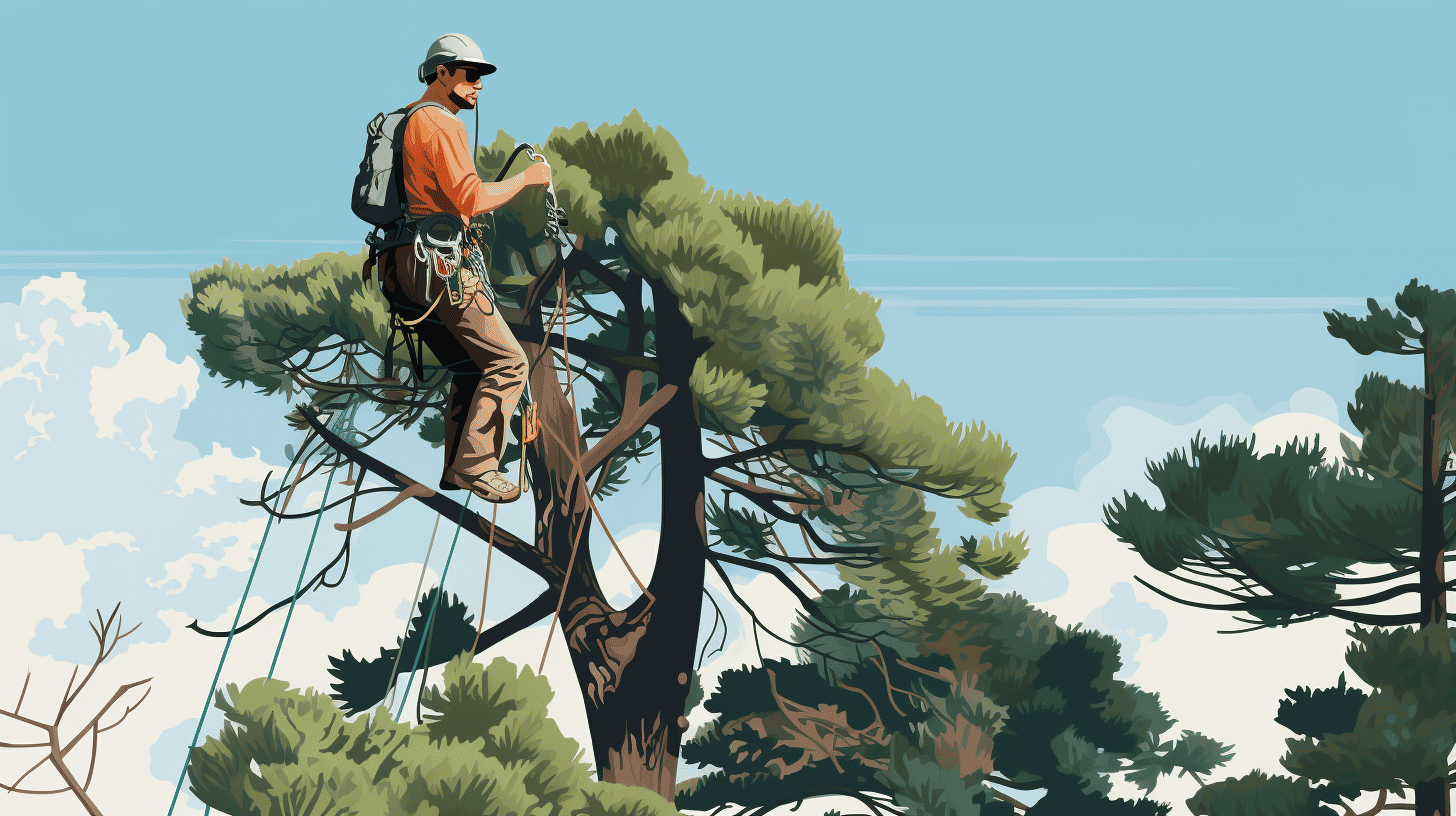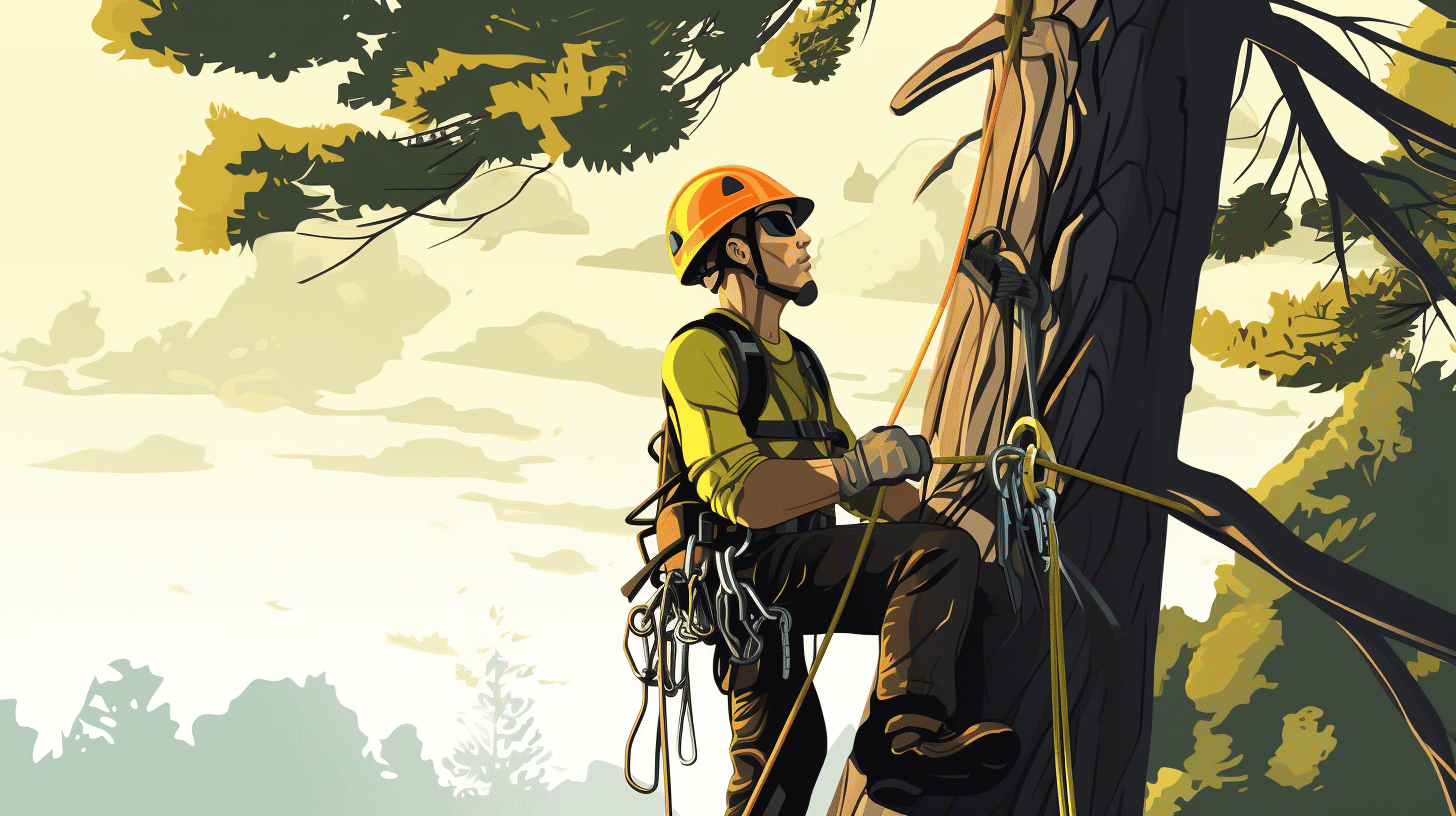Welcome to a thrilling exploration into the world of arboriculture - where the safety of the tree care professionals meets the exhilaration of outdoor activities. This article unfolds a comprehensive perspective on the dynamic intersection between these two elements, offering valuable insights for tree experts, business operators, safety professionals, and anyone with a passion for making outdoor work safer. We'll dive deep into the challenges and safety precautions in the tree trimming industry, tackle some hard statistics around fatalities and injuries, and explore the promising role that outdoor activities play in enhancing arborist safety. So, strap on your safety harnesses and join us for a high-climbing adventure into the branches of arboriculture safety knowledge!
Challenges in Arborist Safety
When you consider high-risk jobs, your mind might leap to those involving heights, heavy machinery, or extreme weather conditions. Indeed, these factors greatly contribute to occupational hazards. However, it's critical not to overlook a sector that, despite its importance, often goes unsung when it comes to discussions on dangerous jobs: the arboriculture industry or, more specifically, the role of the arborist.
Arborists are professionals who manage and care for trees. These individuals, often referred to as tree surgeons, undertake activities spanning from root management, disease diagnosis, to tree-felling. Given the nature of their work, arborists are often exposed to an alarming variety of risks.
According to the factuality statistics, tree workers experience a fatality rate 15 times higher than the combined for all industries. This statistic is a poignant reminder that the necessity of their work comes with substantial peril.
Not only do arborists face a high death risk, but they're also subject to a significant injury rate. For every 10,000 tree workers, almost 240 will experience a non-fatal injury. If we expand the scope to include 100,000 workers, you'll find an annual fatality rate of about 30.0 - almost eight times higher than the national average for all jobs.
When comparing arboriculture to other high-risk professions within the US, this sector emerges as the fourth most dangerous job. Interestingly, tree care workers' major injury incidence rate exceeds even that of the construction industry.
To better comprehend the deep-seated issues behind these alarming statistics, it's necessary to articulate the various challenges and hazards arborists encounter daily:
- Work at height: Arborists spend a significant portion of their shift working at heights, facing risks from faulty equipment, falling, and extreme weather conditions.
- Powerful machinery: They often use chainsaws, woodchippers, and other heavy machinery, increasing the risk of severe injuries.
- Fallen objects: Arborists also contend with the danger of falling branches or other debris, which can cause grave harm.
This stark reality underscores the urgent need for greater emphasis on safety within the arboriculture field. Implementing more comprehensive training, advancing protective equipment, and reinforcing safety regulations could significantly reduce these daunting figures.
Remember, while every occupation comes with its inherent risks, the health and safety of workers should never be a concession.
Growth of Tree Trimming Industry
Within the kaleidoscope of industries contributing to the growth of the American economy, the tree-trimming sector has shown surprising vigor with steady growth since 2018. In a world becoming increasingly green-aware, the importance of professional tree trimming in maintaining the healthiness of our trees and overall environment is being recognized and appreciated. Consequently, the industry is blossoming at a remarkable pace.
Growth Statistics
Immersing ourselves in the numbers, we can truly appreciate the growth of the tree trimming industry. Between 2018 and 2023, the tree trimming industry in America has seen an average growth of 5.9%. This demonstrates that more and more people are understanding the significance of this niche but vital sector.
However, there's another side to this upward trajectory that needs to be considered. A notable percentage of accidents occur in this industry. For instance, in California alone, 68 tree trimmers lost their lives on the job between 2011 and 2021. This data sheds light on the inherent risks associated with the industry, underscoring the essential demand for emphasis on safety measures and protective gear, as well as training.
Let's widen the lens a bit further - around 580 people succumbed to tree trimming accidents from 2009 through 2015, a sobering statistic that underlines the potential dangers and risks the industry faces. Despite such adversity, the determination and hard work of the professionals within this sector resulted in significant growth.
Suffice it to say, the tree trimming industry's growth story is a fascinating blend of success and risks, thriving amidst challenges. The statistics underline the indispensable value of maintaining safety while enjoying the fruits of growth.
Fatalities and Injuries in Arboriculture
Arboriculture: it's not for the faint of heart. As an arborist, perched high in the tree, you dance with danger. The height alone can set the heart racing. Throw in a chainsaw, and the risks multiply. Here, we immerse ourselves in the stark realities arborists face daily, unarmed truths that hide behind leafy green facades. After all, knowledge is power, and power is safety.
Chainsaw Injuries
The chainsaw, while an indispensable tool in arboriculture, is often the main antagonist in a harrowing tale of injuries. Every year, arborists account for as many as 23,000 chainsaw injuries in North America alone. It's a staggering figure, a grim telltale of the dangers lurking in this leafy profession.
Nevertheless, the arborist's reliance on chainsaws is inescapable. They are essential in selective felling, pruning, and even tree habilitation. Therefore, arborists cannot shelve these tools for the sake of safety. As such, resolving the crisis of chainsaw injuries in arboriculture demands a different approach. It compels us to seek out improved safety measures.
The best starting point in this safety crusade is enhancing chainsaw handling skills. Proper handling can significantly minimize the risk of injury. Moreover, the use of safety gear, such as chainsaw chaps and boots, can provide a much-needed protective shield against potential injuries.
Arborists work in one of the most hazardous industries in the world and hence, the importance of safety precautions cannot be overemphasized. The right equipment, tools, and training can mitigate the dangers they are exposed to. Besides, staying updated on the latest techniques and equipment in the industry can help in reducing the risk of injuries.
Worker Deaths Resist
While chainsaw injuries might be the most common, they are far from the only risk arborists face. More darkly, the profession accounts for 80 worker deaths each year. The towering heights, power equipment, the unpredictable nature of the work — all play a role in this sombre statistic.
The tree care industry has to confront itself about these avoidable fatalities. Change is needed, starting with stricter laws and regulations that prioritize worker safety. A focused commitment to safety training could be a life-saving measure for arborists.
In addition, employing advanced technology could make a significant difference. For instance, the use of drones can assist in checking tree health or site conditions without endangering human lives.
Death is a heavy price to pay for work. Arboriculture doesn't have to carry such a dire tag. With a collective and conscious effort to improve safety standards, the industry can change the narrative. We have to remember that every life counts.
In the world of arboriculture, the beauty of trees is not without its dangers. But with an informed perspective, the prompt use of protective measures, adherence to professional training, and the embrace of evolving technology, we can ensure that the risks are minimized. Now more than ever, it's crucial to prioritize safety in the tree care industry. After all, life is precious, and it must not be overshadowed by the towering dangers of the profession.
Safety Measures in Arboriculture
In a profession steeped in risks as pronounced as arboriculture, safety measures aren't optional; they're downright integral. Arborists, characteristically, are daredevils, often dangling from tall trees to prune limbs and even cutting down hazardous trees. While this might sound audacious to some, it's business as usual in the arboriculture sphere. Nevertheless, safety should never be compromised for the thrill of the job.
Present Regulations
Topping the list of safety measures for arborists are several robust and unyielding regulations. In countries around the globe, government bodies mandate these regulations to ensure arborists' well-being while working. For instance, in the United States, the Occupational Safety and Health Administration (OSHA) stipulates the use of harnesses and helmets. Similarly, in Australia, the Government strictly enforces the use of machinery safeguarding to shield arborists from harm.
Here are some overarching regulations:
- Mandatory use of safety equipment: The law requires arborists to use safety helmets, harnesses, and steel-toed boots among other defensive gear.
- Safety training: Arborists must undergo safety training before taking on tasks that involve climbing trees or using heavy machinery.
- Proper use of machinery: All equipment has to be inspected for defects before use, and must be used in observance of safety regulations.
Safety Equipment
Sure, an arborist might seem as brave as they come - fearlessly scaling lofty trees day in, day out. However, don't be deceived – a significant part of these gutsy feats rests on the safety gear donned by the said arborists.
The use of safety equipment is pivotal to protection from the harsh realities of weather and general outdoor work. Each piece of equipment serves its own purpose; protective glasses safeguard your eyes from debris, gloves protect your hands from abrasions, steel-toed boots prevent your feet from crushing injuries. Importantly, rain gear ensures you are dry and comfortable in wet weather while working outdoors. Choosing the Best Rain Gear for Outdoor work should be of utmost priority.
Arborists gear-up to safely navigate their perilous occupation terrain, ticking off a gear checklist something like:
- Helmets: For protection from falling debris
- Safety harnesses: To ensure you’re secured while climbing
- Protective glasses: To shield the eyes from dust and debris
- Gloves: For proper grip and hand protection
- Steel-toed boots: To safeguard the feet against crushing injuries
- Rain Gear: To keep you dry and comfortable in wet weather
Training and Education
Last but definitely not least, let's dive into the crux of arborist safety: training and education. The vitality of comprehensive safety training can't be understated in a profession as complicated as arboriculture. Pruning perilous branches, operating complex machinery, and spotting hazards are all part and parcel of an arborist's role. Needless to say, performing these tasks safely requires dedicated training.
Moreover, safety education isn't a one-off event, rather a continuous process. Arborists ought to be updated about the latest safety practices, tree diseases, machinery syntax, and emergency protocols. Invariably, safety in this line of work is a cocktail of meticulous training, rigorous education, and, of course, the right safety equipment.
To sum up, arboriculture is indeed a high-risk job and calls for a similarly high degree of safety measures. With firm regulations in place, the right safety equipment, and comprehensive training programs, arborists can continue doing what they do best: scaling the heights in their pursuit of safer, healthier trees.
Role of Outdoor Activities in Arborist Safety
The duties of an arborist are often physically demanding and laden with potential hazards. Thus, maintaining a high level of physical fitness and awareness can surprisingly impact an arborist's overall safety and efficiency. Could some fun and adventure be blended into this seemingly stern need for safety? Absolutely! The integration of outdoor activities into an arborist's fitness regime could be an invigorating solution - converging enjoyment, fitness, and enhanced work safety.
Outdoor activities like hiking, rock climbing, and trail running can provide the multi-faceted fitness requirements that any arborist needs. Their safety demands a balanced cocktail of strength, agility, endurance, and mental alertness - factors improved by these heart-pumping pursuits.
To illustrate:
- Strength and Endurance: Regularly engaging in outdoor activities like cycling up hilly terrains can build lower body strength and cardiovascular endurance, which are fundamental for the rigorous climbing and lifting arborists often undertake.
- Boost in Agility: Swift reactions and nimble movements are crucial for staying safe while maneuvering around trees. Activities like trail running or playing football can refine these qualities.
- Mental Alertness: When it comes to safety, strong mental acuity is just as significant as physical prowess. Mind-challenging activities like orienteering or geocaching can hone this critical skill.
Including these activities in a regular fitness routine does not just hoist arborists' physical readiness. It also opens windows for relaxation and healthy stress-releasing outlets, further advancing emotional well-being and mental resilience - two overlooked components of safety.
Now let's shatter a popular misconception. Outdoor activities don't have to be costly or time-consuming sports, warranted by exorbitant gear and long trips. They can be easily incorporated into our day-to-day life. For instance, instead of driving to the grocery store, why not walk or cycle? This simple adjustment can grant meaningful benefits over time. Or, invite family or friends for a weekend hike or a friendly football match. This couples bonding and fitness, weaving a stronger social fabric which in turn amplifies their resilience at work.
So, arborists, slip into a comfy pair of running shoes and head towards your closest trail. Injecting a dose of outdoor enthusiasm into your fitness agenda will costume you better for your role way up in the trees. It's safety and delight, twined into a fascinating pursuit of health and happiness. This is not merely about keeping fit and ready for work, but nurturing an all-round holistic lifestyle that simultaneously champions safety and joy.
Conclusion
In the perseverance of safeguarding arborists in their demanding and precarious line of work, continuous improvements in the field of outdoor activities and personal protective equipment are indispensable. The rise of outdoor pursuits not only bolsters arboriculture's growth but remarkably manifests a symbiotic relationship imbued with safety consciousness.
The exponential evolution in the tree-trimming industry and the heart-rending experiences of arborists emulate the urgent requirement for superior safety protocols. This need also extends to the manufacturing of high-quality, durable, and protective gear. That’s where Rain Gear Pro steps in. They offer chainsaw safety pants, a formidable line of defense for arborists. These precision-crafted saw pants, engineered to endure crotch blowout, merge unprecedented protection with outstanding comfort.
Along with engaging in safety training and education, the adoption of resilient gear such as Rain Gear Pro's chainsaw safety pants could herald a new era in arborist safety. Ultimately, embracing these transformative strides towards a safer arboriculture industry not only fortifies the safety of arborists but ensures the thriving continuity of this essential service.
Frequently Asked Questions
-
What is the importance of outdoor activities in arborist safety?
Outdoor activities play a crucial role in arborist safety as they provide practical and hands-on training opportunities for arborists to develop their skills, increase their knowledge, and improve their decision-making abilities in real-life situations.
-
What are some common outdoor activities that enhance arborist safety?
Some common outdoor activities that enhance arborist safety include tree climbing exercises, aerial rescue simulations, equipment operation training, hazard identification drills, and practicing emergency response procedures.
-
How do outdoor activities contribute to the overall development of arborist safety?
Outdoor activities contribute to the overall development of arborist safety by providing hands-on experience, promoting teamwork and communication skills, building physical strength and agility, and fostering a better understanding of the natural environment and tree dynamics.
-
Are there any specific safety regulations or standards for outdoor activities in arboriculture?
Yes, there are specific safety regulations and standards for outdoor activities in arboriculture. These may include adherence to industry best practices, following safety guidelines outlined by organizations like the Occupational Safety and Health Administration (OSHA), and complying with local regulations and certification requirements.
-
How can arborist companies incorporate outdoor activities into their safety training programs?
Arborist companies can incorporate outdoor activities into their safety training programs by partnering with experienced trainers or experts, organizing regular field training sessions, utilizing specialized equipment and simulators, conducting risk assessments, and promoting a culture of continuous learning and improvement.























Leave a comment
This site is protected by hCaptcha and the hCaptcha Privacy Policy and Terms of Service apply.